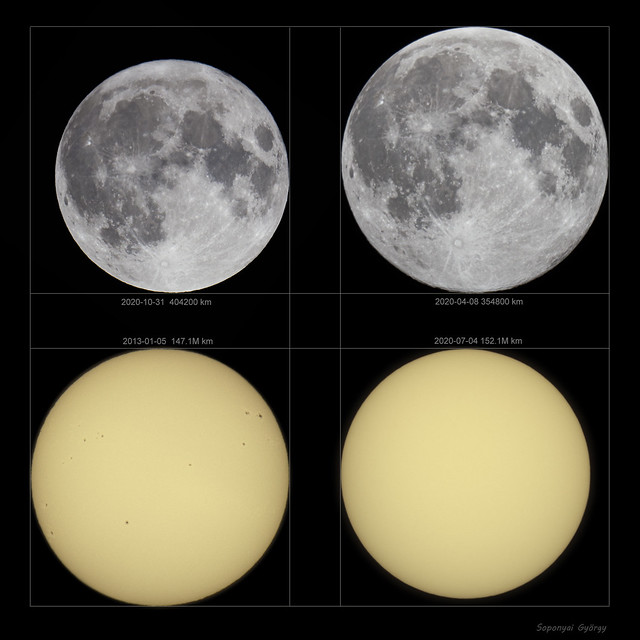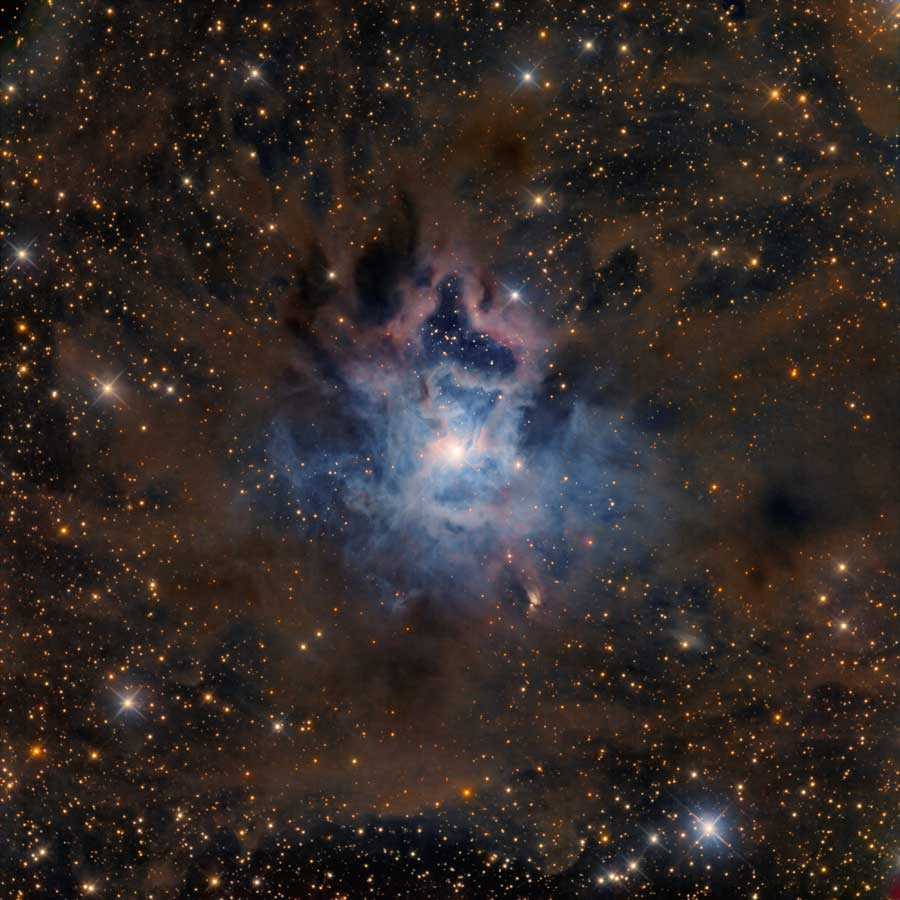Submissions: 2020 November
Submissions: 2020 November
__________________________________________________________________________________________________
Please post your images here.
Please see this thread before posting images; posting images demonstrates your agreement with
the possible uses for your image.
If hotlinking to an image, please ensure it is under 500K.
Hotlinks to images over 500K slow down the thread too much and will be disabled.
Thank you!
_________________________________________________________________________________________________
<- Previous submissions
Please post your images here.
Please see this thread before posting images; posting images demonstrates your agreement with
the possible uses for your image.
If hotlinking to an image, please ensure it is under 500K.
Hotlinks to images over 500K slow down the thread too much and will be disabled.
Thank you!
_________________________________________________________________________________________________
<- Previous submissions
A closed mouth gathers no foot.
-
thomasroell
- Ensign
- Posts: 28
- Joined: Tue Oct 27, 2020 7:23 pm
Re: Submissions: 2020 November
This image is the popular target the Pelican Nebula, IC 5070, but flipped 180 degrees to make the bright “wall’ more prominent. It very much resembles the nearby Cygnus Wall.
This was shot two weeks ago from my home in the northern part of The Netherlands.
Optics: TS-Optics 115mm Triplet APO
Camera: Astro modified Canon 750D, Optolong L-Enhance filter
Subs: 40 x 600 seconds ISO 3200
Regards Thomas
This was shot two weeks ago from my home in the northern part of The Netherlands.
Optics: TS-Optics 115mm Triplet APO
Camera: Astro modified Canon 750D, Optolong L-Enhance filter
Subs: 40 x 600 seconds ISO 3200
Regards Thomas
-
Wissam Ayoub
- Ensign
- Posts: 33
- Joined: Tue Oct 13, 2020 5:40 pm
Re: Submissions: 2020 November
Hi,
Thank you so much for this opportunity,
I also submitted my image yesterday in the October 2020 submissions due to the time difference with the US as the November submissions page was not yet available
Sorry for any duplicated data.
My submission: The HEART of the Lagoon Nebula M8


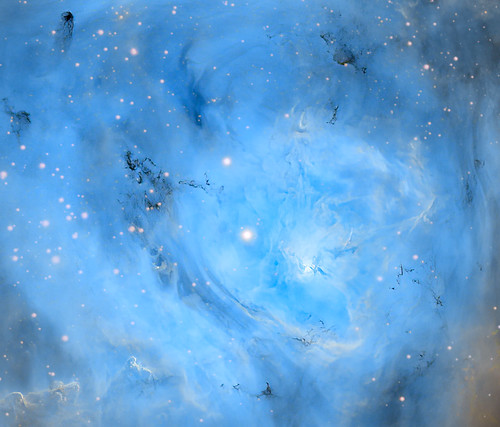
Imaging telescope: Explore Scientific 127mm ED TRIPLET APO.
Imaging camera: ZWO ASI1600MM Pro-Cool.
Focal reducer: Explore Scientific 0.7 Reducer/Flattener.
Mounts: iOptron CEM60.
Software: Photoshop CC 2020 Photoshop · PixInsight 1.8.8 Ripley · DeepSky Stacker (DSS) Deepskystacker 3.3.6
Filters:
Astronomik SII 1.25" 12 nm
Astronomik Ha 1,25" 12 nm
Astronomik OIII 1.25" 12nm
Locations: UAE desert, Abu Dhabi, United Arab Emirates
Copyright: Wissam Ayoub
Thank you,
Thank you so much for this opportunity,
I also submitted my image yesterday in the October 2020 submissions due to the time difference with the US as the November submissions page was not yet available
Sorry for any duplicated data.
My submission: The HEART of the Lagoon Nebula M8



Imaging telescope: Explore Scientific 127mm ED TRIPLET APO.
Imaging camera: ZWO ASI1600MM Pro-Cool.
Focal reducer: Explore Scientific 0.7 Reducer/Flattener.
Mounts: iOptron CEM60.
Software: Photoshop CC 2020 Photoshop · PixInsight 1.8.8 Ripley · DeepSky Stacker (DSS) Deepskystacker 3.3.6
Filters:
Astronomik SII 1.25" 12 nm
Astronomik Ha 1,25" 12 nm
Astronomik OIII 1.25" 12nm
Locations: UAE desert, Abu Dhabi, United Arab Emirates
Copyright: Wissam Ayoub
Thank you,
Sadr and Crecent
Sadr and Crecent
www.SkyandPhoto.com
Copyright: Rafael Rodriguez Morales
https://www.cieloyfoto.es/2020/10/sadr-y-crecent.html
Sadr (Gamma Sygni) is the star found at the junction of the two suits of the northern cross that represents the constellation of the Swan. Behind it hides a very extensive and active region in alpha hydrogen (Ha) (IC1318). The crescent nebula, crescent or crescent (NGC6888) located about 6º southwest of Sadr, is located 3700 light years from Earth.
This photo is a composition of a large field from a city, with skies with a lot of light pollution. A new narrow band filter of Ha and OIII has been used for color cameras, the results being appreciated.
Take from Mairena del Aljarafe (Sevilla, Spain) 5, 6, 7 of octubre 2020.
Takahashi FS60 CB.
Reducertor Takahashi x72.
Takahashi EM200 Temma2.
CMOS QHY 367C .withcon cámara QHY5 II.
Exposures 20x 1200"
Filter STC dual narrow band
Pixinsight 1.8.8.
www.SkyandPhoto.com
Copyright: Rafael Rodriguez Morales
https://www.cieloyfoto.es/2020/10/sadr-y-crecent.html
Sadr (Gamma Sygni) is the star found at the junction of the two suits of the northern cross that represents the constellation of the Swan. Behind it hides a very extensive and active region in alpha hydrogen (Ha) (IC1318). The crescent nebula, crescent or crescent (NGC6888) located about 6º southwest of Sadr, is located 3700 light years from Earth.
This photo is a composition of a large field from a city, with skies with a lot of light pollution. A new narrow band filter of Ha and OIII has been used for color cameras, the results being appreciated.
Take from Mairena del Aljarafe (Sevilla, Spain) 5, 6, 7 of octubre 2020.
Takahashi FS60 CB.
Reducertor Takahashi x72.
Takahashi EM200 Temma2.
CMOS QHY 367C .withcon cámara QHY5 II.
Exposures 20x 1200"
Filter STC dual narrow band
Pixinsight 1.8.8.
Last edited by RafaRo on Mon Nov 02, 2020 2:52 pm, edited 3 times in total.
-
Thierry Legault
- Ensign
- Posts: 85
- Joined: Wed May 26, 2010 4:45 pm
Re: Submissions: 2020 November
Image of Mars taken with the 1-meter telescope at the Pic-du-Midi observatory (France) on Oct 30th.

The full image: http://www.astrosurf.com/eternity/JLD/2 ... e_apod.jpg
A gif showing the rotation of Mars during 40 minutes: http://www.astrosurf.com/eternity/JLD/2 ... 316600.gif
The Pic du Midi observatory has been known since the 19th century to produce the best images of planets from the ground.
For a long time, visual observations and drawing have surpassed photographic sensors, they were made with a 38 cm refractor.
http://articles.adsabs.harvard.edu/pdf/ ... ..57...49C
In the sixties a 1-meter telescope was installed at the Pic du Midi, it was partially
funded by NASA to produce the best protographic atlas of the Moon for the Apollo missions.
https://science.sciencemag.org/content/132/3422/290.2
Since that time the 1-meter telescope has been mainly used for planetology programs.
The image shows the progress made since the 80's from the end of the use of silver photography to now with CMOS sensors. One notices however the similarity
and the compactness of the sensors at the Cassegrain focus of the telescope. This last image of Mars is a new milestone for ground based observatories.
Historical pictures of the observatory:

Larger image: http://www.astrosurf.com/eternity/JLD/IMFR0441.jpg

The full image: http://www.astrosurf.com/eternity/JLD/2 ... e_apod.jpg
A gif showing the rotation of Mars during 40 minutes: http://www.astrosurf.com/eternity/JLD/2 ... 316600.gif
The Pic du Midi observatory has been known since the 19th century to produce the best images of planets from the ground.
For a long time, visual observations and drawing have surpassed photographic sensors, they were made with a 38 cm refractor.
http://articles.adsabs.harvard.edu/pdf/ ... ..57...49C
In the sixties a 1-meter telescope was installed at the Pic du Midi, it was partially
funded by NASA to produce the best protographic atlas of the Moon for the Apollo missions.
https://science.sciencemag.org/content/132/3422/290.2
Since that time the 1-meter telescope has been mainly used for planetology programs.
The image shows the progress made since the 80's from the end of the use of silver photography to now with CMOS sensors. One notices however the similarity
and the compactness of the sensors at the Cassegrain focus of the telescope. This last image of Mars is a new milestone for ground based observatories.
Historical pictures of the observatory:

Larger image: http://www.astrosurf.com/eternity/JLD/IMFR0441.jpg
Last edited by Thierry Legault on Mon Nov 02, 2020 3:11 pm, edited 1 time in total.
Re: Submissions: 2020 November
COOCON CLOUDS
www.SkyandPhoto.com
Copyright: Rafael Rodriguez Morales
https://www.cieloyfoto.es/2020/10/las-n ... oocon.html
This photograph located in the swan constellation, unites the Coocon IC 5146 nebula (right) with the dark nebula Barnard 168 (pcenter path and left), having the special characteristic that the dark nebula stands out with its details. Normally in the photographs that are made of this area it is shown as totally dark paths that do not show the nebula and that hides the stars in the background.
IC5146 is a reflection / emission nebula and Barbard 168 is a long interstellar cloud, both besieged about 3300 light years away.
Photograph captured in the northern sierra of Seville (Spain) on the night of October 11-12, with the following equipment and capture data
SuperApochromatic Telescope TMB 130/780 CNC II.
Massimo Riccardi Reducer / Flattener x0.75 of 81 mm.
Focal 585mm at F4.5.
Takahashi EM200 Temma2 mount.
QHY 367C Cold CMOS Camera.
Guided with the main camera, OAG with QHY5 LII camera.
Sensor temperature of - 10ºC.
Exposures 18x 600 ". RGB
Pixinsight 1.8.8.
www.SkyandPhoto.com
Copyright: Rafael Rodriguez Morales
https://www.cieloyfoto.es/2020/10/las-n ... oocon.html
This photograph located in the swan constellation, unites the Coocon IC 5146 nebula (right) with the dark nebula Barnard 168 (pcenter path and left), having the special characteristic that the dark nebula stands out with its details. Normally in the photographs that are made of this area it is shown as totally dark paths that do not show the nebula and that hides the stars in the background.
IC5146 is a reflection / emission nebula and Barbard 168 is a long interstellar cloud, both besieged about 3300 light years away.
Photograph captured in the northern sierra of Seville (Spain) on the night of October 11-12, with the following equipment and capture data
SuperApochromatic Telescope TMB 130/780 CNC II.
Massimo Riccardi Reducer / Flattener x0.75 of 81 mm.
Focal 585mm at F4.5.
Takahashi EM200 Temma2 mount.
QHY 367C Cold CMOS Camera.
Guided with the main camera, OAG with QHY5 LII camera.
Sensor temperature of - 10ºC.
Exposures 18x 600 ". RGB
Pixinsight 1.8.8.
Last edited by RafaRo on Mon Nov 02, 2020 3:12 pm, edited 1 time in total.
Re: Submissions: 2020 November
A SEAHORSE IN THE OCEAN
www.SkyandPhoto.com
Copyright: Rafael Rodriguez Morales
https://www.cieloyfoto.es/2020/10/un-ca ... ceano.html
The dark nebula cataloged as Banard 150 has the shape of a seahorse, coincidences, In this photograph of great field and detail it is immersed in the great Ocean of the universe, in this case a part of the Milky Way that falls towards the left to the reduce the number of stars.
You can see the Fireworks Galaxy (NGC 6946) and below a globular star cluster (NGC6939).
Photograph captured in the northern mountains of Seville (Spain) on the night of October 17 to 18, with the following equipment and capture data:
SuperApochromatic Telescope TMB 130/780 CNC II.
Massimo Riccardi Reducer / Flattener x0.75 of 81 mm.
Focal 585mm at F4.5.
Takahashi EM200 Temma2 mount.
QHY 367C Cold CMOS Camera.
Guided with the main camera, OAG with QHY5 LII camera.
Sensor temperature of - 10ºC.
Exposures 20x 600 ". RGB
Pixinsight 1.8.8.
www.SkyandPhoto.com
Copyright: Rafael Rodriguez Morales
https://www.cieloyfoto.es/2020/10/un-ca ... ceano.html
The dark nebula cataloged as Banard 150 has the shape of a seahorse, coincidences, In this photograph of great field and detail it is immersed in the great Ocean of the universe, in this case a part of the Milky Way that falls towards the left to the reduce the number of stars.
You can see the Fireworks Galaxy (NGC 6946) and below a globular star cluster (NGC6939).
Photograph captured in the northern mountains of Seville (Spain) on the night of October 17 to 18, with the following equipment and capture data:
SuperApochromatic Telescope TMB 130/780 CNC II.
Massimo Riccardi Reducer / Flattener x0.75 of 81 mm.
Focal 585mm at F4.5.
Takahashi EM200 Temma2 mount.
QHY 367C Cold CMOS Camera.
Guided with the main camera, OAG with QHY5 LII camera.
Sensor temperature of - 10ºC.
Exposures 20x 600 ". RGB
Pixinsight 1.8.8.
-
cappellettiariel
- Ensign
- Posts: 21
- Joined: Sat Aug 11, 2018 3:18 pm
Re: Submissions: 2020 November
Hi everyone, I hope you are having a great day, I would like to share this rendition of NGC 2070 - Tarantula Nebula in Hubble Palette, captured on final nights of October and first night of November of 2020.
Total Integration time: 13.7 h, from Córdoba, Argentina.
I hope you enjoy it. Clear Skies!
Technical data:
Main Equipment: ZWO ASI 1600 mm-pro + SW Explorer 250pds + SW Coma Corrector 0.9x + EQ6-R-Pro + ZWO EAF + ZWO 7x2" EFW
Guiding: starguider 60/240 mm, ZWO ASI 120mm mini
*Gain 139, -20 º C, Ha 7nm 2" Optolong, 140x180"
*Gain 139, -20 º C, Oiii-CCD 6.5 nm 2" Optolong, 72x180"
*Gain 139, -20 º C, Sii-CCD 6.5 nm 2" Optolong, 62x180"
100 Darks
100 Flats / filter
Polar Align: SharpCap 3.2
Adquisición: SGP 3.1
Procesado: Pixinsight 1.8.8, PS

NGC 2070 - Tarantula - SHO by Ariel Cappelletti, en Flickr
Total Integration time: 13.7 h, from Córdoba, Argentina.
I hope you enjoy it. Clear Skies!
Technical data:
Main Equipment: ZWO ASI 1600 mm-pro + SW Explorer 250pds + SW Coma Corrector 0.9x + EQ6-R-Pro + ZWO EAF + ZWO 7x2" EFW
Guiding: starguider 60/240 mm, ZWO ASI 120mm mini
*Gain 139, -20 º C, Ha 7nm 2" Optolong, 140x180"
*Gain 139, -20 º C, Oiii-CCD 6.5 nm 2" Optolong, 72x180"
*Gain 139, -20 º C, Sii-CCD 6.5 nm 2" Optolong, 62x180"
100 Darks
100 Flats / filter
Polar Align: SharpCap 3.2
Adquisición: SGP 3.1
Procesado: Pixinsight 1.8.8, PS

NGC 2070 - Tarantula - SHO by Ariel Cappelletti, en Flickr
Last edited by cappellettiariel on Mon Nov 02, 2020 10:29 pm, edited 1 time in total.
-
Andromeda 2013
- Science Officer
- Posts: 196
- Joined: Tue Jul 09, 2013 2:11 pm
- Contact:
-
Andromeda 2013
- Science Officer
- Posts: 196
- Joined: Tue Jul 09, 2013 2:11 pm
- Contact:
Re: Submissions: 2020 November
M-51
https://www.flickr.com/photos/92681330@N06/50531328551
"Image Acquisition by Jim Misti"
Ritchey-Chretien 32" Telescope - F7.2 - SBIG STL-11000 CCD camera
processed by me: APP, P.I. PCC
Copyright: Daniel Pasternak ©
https://www.flickr.com/photos/92681330@N06/50531328551
"Image Acquisition by Jim Misti"
Ritchey-Chretien 32" Telescope - F7.2 - SBIG STL-11000 CCD camera
processed by me: APP, P.I. PCC
Copyright: Daniel Pasternak ©
-
Andromeda 2013
- Science Officer
- Posts: 196
- Joined: Tue Jul 09, 2013 2:11 pm
- Contact:
Re: Submissions: 2020 November
4 Panel Blue Moon
https://www.flickr.com/photos/92681330@N06/50555605347
Copyright: Daniel Pasternak ©
https://www.flickr.com/photos/92681330@N06/50555605347
Copyright: Daniel Pasternak ©
-
Andromeda 2013
- Science Officer
- Posts: 196
- Joined: Tue Jul 09, 2013 2:11 pm
- Contact:
Re: Submissions: 2020 November
14 Panel Blue Moon
https://www.flickr.com/photos/92681330@N06/50557800212
C-11 2800MM 2600
CLICK ON LINK ABOVE AND KEEP ZOOMING IN TO THE MOON FOR A WALK-ABOUT.
Copyright: Daniel Pasternak ©
https://www.flickr.com/photos/92681330@N06/50557800212
C-11 2800MM 2600
CLICK ON LINK ABOVE AND KEEP ZOOMING IN TO THE MOON FOR A WALK-ABOUT.
Copyright: Daniel Pasternak ©
-
Andromeda 2013
- Science Officer
- Posts: 196
- Joined: Tue Jul 09, 2013 2:11 pm
- Contact:
Re: Submissions: 2020 November
- Attachments
-
- Daniel Pasternak 9 Oct 2020.jpg (23.3 KiB) Viewed 324823 times
-
barretosmed
- Science Officer
- Posts: 482
- Joined: Thu Oct 12, 2017 6:04 pm
Re: Submissions: 2020 November
The large, ancient and worn-out J HERSCHEL crater
J HERSCHEL is an ancient, large and worn-out impact crater ("walled plain") located on the northern part of the Moon's surface.
The rim of this crater has been heavily eroded to the point that it is often described as "considerably disintegrated". The remaining edge survives like a ring of ridges that have been cut out by subsequent impacts. The internal floor is relatively flat, but irregular and marked by an infinity of small impacts
BEST DETAILS
https://www.astrobin.com/full/q8cl4q/C/?nc=user
Equipment
MEADE LX200 10 "UHTC
ZWO Optical ASI 462MC
Filter: Planetary Baader L 1.25 "
Accessory: TeleVue Powermate 2.0x
Mount: Ioptron Cem60
Polar alignment: Sharcap
Capture: SharpCap V3.0
Processing: Photoshop CS6 ,, AutoStakkert AutoStackert !, Registax 6.
10/28/2020
São Paulo-SP-Brazil
Copyright: Fernando Oliveira de Menezes
Email: Barretosmed@hotmail.com
J HERSCHEL is an ancient, large and worn-out impact crater ("walled plain") located on the northern part of the Moon's surface.
The rim of this crater has been heavily eroded to the point that it is often described as "considerably disintegrated". The remaining edge survives like a ring of ridges that have been cut out by subsequent impacts. The internal floor is relatively flat, but irregular and marked by an infinity of small impacts
BEST DETAILS
https://www.astrobin.com/full/q8cl4q/C/?nc=user
Equipment
MEADE LX200 10 "UHTC
ZWO Optical ASI 462MC
Filter: Planetary Baader L 1.25 "
Accessory: TeleVue Powermate 2.0x
Mount: Ioptron Cem60
Polar alignment: Sharcap
Capture: SharpCap V3.0
Processing: Photoshop CS6 ,, AutoStakkert AutoStackert !, Registax 6.
10/28/2020
São Paulo-SP-Brazil
Copyright: Fernando Oliveira de Menezes
Email: Barretosmed@hotmail.com
-
cappellettiariel
- Ensign
- Posts: 21
- Joined: Sat Aug 11, 2018 3:18 pm
Re: Submissions: 2020 November
Hi everyone, I hope you are having a great day, I would like to share a Bicolor HOO rendition of NGC 2070 - Tarantula Nebula, captured on final nights of October and first night of November of 2020.
Total Integration time: 10.6 h, from Córdoba, Argentina.
I hope you enjoy it. Clear Skies!
Technical data:
Main Equipment: ZWO ASI 1600 mm-pro + SW Explorer 250pds + SW Coma Corrector 0.9x + EQ6-R-Pro + ZWO EAF + ZWO 7x2" EFW
Guiding: starguider 60/240 mm, ZWO ASI 120mm mini
*Gain 139, -20 º C, Ha 7nm 2" Optolong, 140x180"
*Gain 139, -20 º C, Oiii-CCD 6.5 nm 2" Optolong, 72x180"
100 Darks
100 Flats / filter
Polar Align: SharpCap 3.2
Adquisición: SGP 3.1
Procesado: Pixinsight 1.8.8, PS

NGC 2070 - Bicolor (HOO) by Ariel Cappelletti, en Flickr
Total Integration time: 10.6 h, from Córdoba, Argentina.
I hope you enjoy it. Clear Skies!
Technical data:
Main Equipment: ZWO ASI 1600 mm-pro + SW Explorer 250pds + SW Coma Corrector 0.9x + EQ6-R-Pro + ZWO EAF + ZWO 7x2" EFW
Guiding: starguider 60/240 mm, ZWO ASI 120mm mini
*Gain 139, -20 º C, Ha 7nm 2" Optolong, 140x180"
*Gain 139, -20 º C, Oiii-CCD 6.5 nm 2" Optolong, 72x180"
100 Darks
100 Flats / filter
Polar Align: SharpCap 3.2
Adquisición: SGP 3.1
Procesado: Pixinsight 1.8.8, PS

NGC 2070 - Bicolor (HOO) by Ariel Cappelletti, en Flickr
Re: Submissions: 2020 November
 NGC 1499 California Nebula by Connor Mccraw, on Flickr
NGC 1499 California Nebula by Connor Mccraw, on FlickrNgc 1499 California Nebula imaged in Ha and Oiii bicolor. It was imaged with a monochrome astronomy camera from my backyard over the span of a week. The data collected was shot with a 135mm camera lens mounted to my mount.
I enjoy Bicolor images of certain nebula compared to SHO images because the image becomes more bold and vibrant in its final combination.
The image was edited in Pixinsight and finished with Photoshop for final touches.
This image was created with a budget setup of a camera typically used for planetary imaging and a Rokinon 135mm lens on a Ioptron CEM25EC mount. I have been imaging just over a year and feel like my skill set has come a long way and I am learning with every image I produce.
Re: Submissions: 2020 November
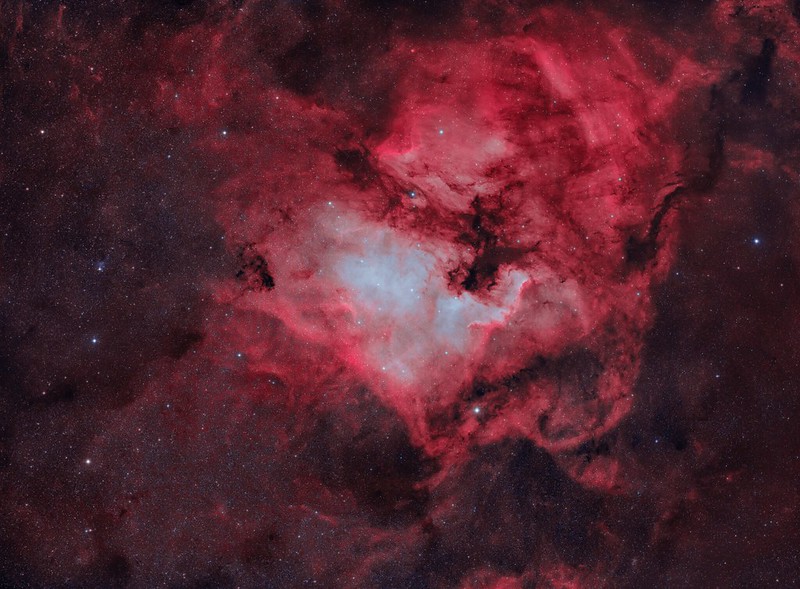 ngc7000social by Connor Mccraw, on Flickr
ngc7000social by Connor Mccraw, on FlickrA widefield of North American Nebula and Pelican Nebula shot with an ZWO asi1600mm pro and Rokinon 135mm lens at F2.
This is a bicolor Ha and Oiii image of this area of the sky with very deep exposures of 600 seconds at F2. Processed in Pixinsight and finished in Photoshop.
This is was my first image produced with ZWO Asi1600mm pro.
-
carlos1818
Nova in Andromeda Galaxy
Click to play embedded YouTube video.
Sometimes it takes luck. I live in south of Brazil, where Andromeda sits low on the sky. So I decided to take 5 minutes pictures for 7 days, in order to overcome city light polution. A few weeks later I found out that a star had exploded near the core, in an event called Nova. It has been discovered and named AT2020vak, so I went back to see my pictures and there it was, from night 5 (18/10/20) to 6 (19/10/20).
I only needed to blink the imagens and create a video with the explosion in a timelapse consisting of 7 days (5 before and 2 after the explosion).
The result has little or no scientific usage, but sure creates a nice view for us to better understand the magnitude of such explosion.
Keep in mind that all the stars you see on this image are from our own galaxy. Andromeda is so far away that we cannot distinguish individual stars, only the ones that explodes
Equipment:
-Explore Scientific APO 102
- ZWO Asi294mcPro
- Ioptron CEM60
- ZWO Asiair
- L-Pro filter
- about 300 x 5 min images
Re: Submissions: 2020 November
Here is a new image of Mars made this 24th October 2020
Re-post of the image in November submission section
This image has been made at UT21:17 with C2PU 1-meter diameter Cassegrain telescope
This image has a resolution going beyond that previously made with this telescope, and shows particularly Valles Marineris with a lot of details I personally have never seen on pictures taken from the ground
Full resolution view here : http://www.astrosurf.com/prostjp/Galeri ... cambre.jpg
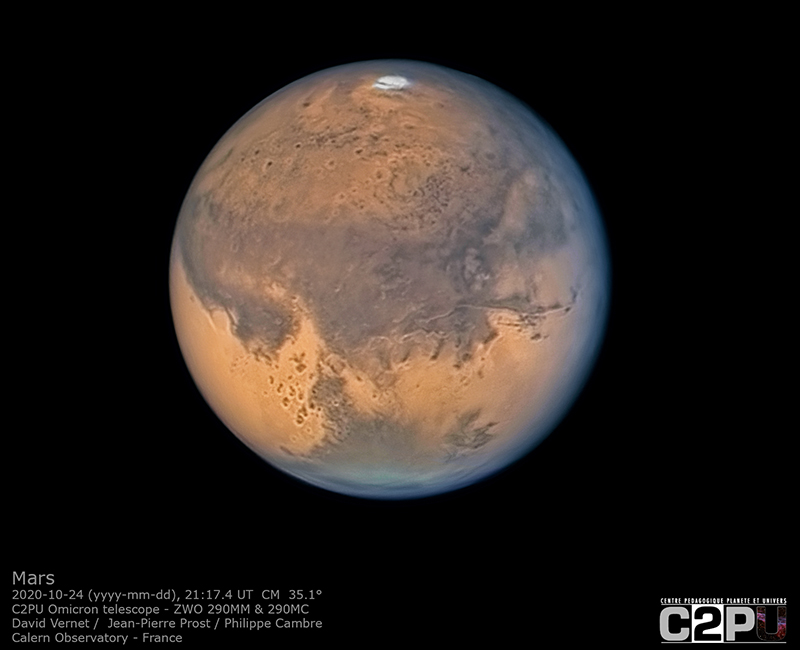
C2PU telescopes are located at Calern Plateau (N +43°45’ E +006° 55’), a well-known spot for astronomy in France due to its regular very good seeing conditions. These telescopes are dedicated to science experiments and research, and to education.

The OMICRON telescope was used for this picture :

Re-post of the image in November submission section
This image has been made at UT21:17 with C2PU 1-meter diameter Cassegrain telescope
This image has a resolution going beyond that previously made with this telescope, and shows particularly Valles Marineris with a lot of details I personally have never seen on pictures taken from the ground
Full resolution view here : http://www.astrosurf.com/prostjp/Galeri ... cambre.jpg

C2PU telescopes are located at Calern Plateau (N +43°45’ E +006° 55’), a well-known spot for astronomy in France due to its regular very good seeing conditions. These telescopes are dedicated to science experiments and research, and to education.

The OMICRON telescope was used for this picture :

-
Thierry Legault
- Ensign
- Posts: 85
- Joined: Wed May 26, 2010 4:45 pm
Re: Submissions: 2020 November
In addition to the Mars image taken with the 1-meter telescope at the Pic-du-Midi posted Nov 2nd, here are two stereoscopic pairs showing Mars in 3D, the first pair for the parallel technique (tip: use two paper or cardboard tubes and hold them like binoculars to keep each eye directed to its corresponding globe - the left eye to the left globe, the right eye to the right globe), the second pair for the cross-eyed technique ("squint" to merge the two globes at the center of the frame).
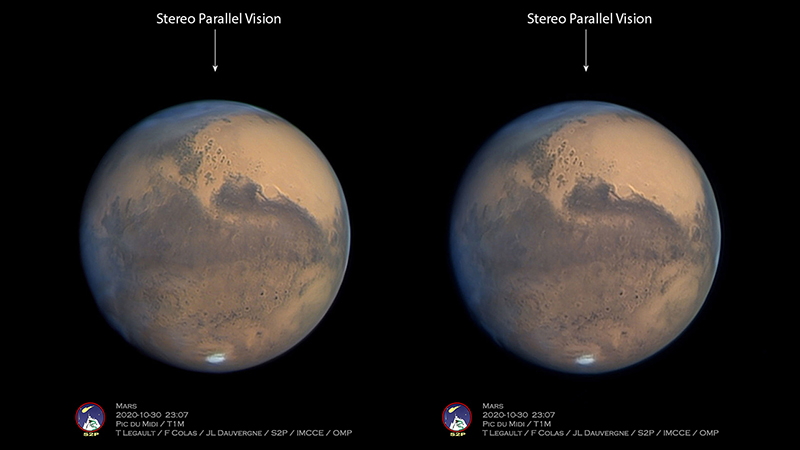
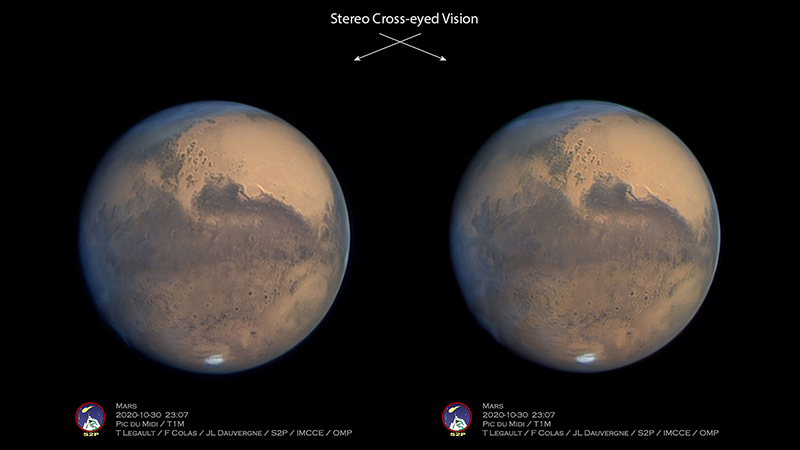
Full images:
http://www.astrophoto.fr/mars-picdumidi ... rallel.jpg
http://www.astrophoto.fr/mars-picdumidi ... s-eyed.jpg


Full images:
http://www.astrophoto.fr/mars-picdumidi ... rallel.jpg
http://www.astrophoto.fr/mars-picdumidi ... s-eyed.jpg
Re: Nova in Andromeda Galaxy
How fascinating, Carlos, and congratulations on catching such a fleeting event (and showing it to us)!carlos1818 wrote: ↑Tue Nov 03, 2020 12:50 pm--Click to play embedded YouTube video.
Sometimes it takes luck. I live in south of Brazil, where Andromeda sits low on the sky. So I decided to take 5 minutes pictures for 7 days, in order to overcome city light polution. A few weeks later I found out that a star had exploded near the core, in an event called Nova. It has been discovered and named AT2020vak, so I went back to see my pictures and there it was, from night 5 (18/10/20) to 6 (19/10/20).
I only needed to blink the imagens and create a video with the explosion in a timelapse consisting of 7 days (5 before and 2 after the explosion).
The result has little or no scientific usage, but sure creates a nice view for us to better understand the magnitude of such explosion.
Keep in mind that all the stars you see on this image are from our own galaxy. Andromeda is so far away that we cannot distinguish individual stars, only the ones that explodes
Equipment:
-Explore Scientific APO 102
- ZWO Asi294mcPro
- Ioptron CEM60
- ZWO Asiair
- L-Pro filter
- about 300 x 5 min images
This reminds me of a supernova that was photographed by photographer James D Wray, and included in his atlas, The Color Atlas of Galaxies from 1988. The supernova, SN 1979C in M100, was bright, and has generated continued interest. But when I googled this supernova I found no actual images of it. There appears to be no pictures of it available on the net, but it is there in James D Wray's photo of galaxy M100.
Capturing fleeting events is important, so congratulations, Carlos!
Ann
Color Commentator
-
vanamonde81
- Science Officer
- Posts: 143
- Joined: Fri Apr 12, 2013 7:46 am
-
akshay87kumar
- Asternaut
- Posts: 1
- Joined: Wed Nov 04, 2020 11:50 am
Re: Submissions: 2020 November
Thanks for the opportunity to post one of my images.
Please see attached some of the images of the full moon taken on the night of the Blue Moon of October 2020 (31 Oct). This is a 150-image stacked photograph created using PIPP and AutoStakkert, with post processing performed in Photoshop. I have increased the saturation of the image to reveal the colors reflected from the lunar surface. The terrain of the moon like craters, maria are also visible.
Equipment: Nikon D5300, Nikon 200-500mm f/5.6
150 exposures at 1/80s, ISO100, 500mm
Also attaching a couple other pictures:
1. Stacked picture of the moon taken on an early evening when the sky had sufficient light.
2. Another full moon stacked image, taken earlier in the year from a different location.
Please see attached some of the images of the full moon taken on the night of the Blue Moon of October 2020 (31 Oct). This is a 150-image stacked photograph created using PIPP and AutoStakkert, with post processing performed in Photoshop. I have increased the saturation of the image to reveal the colors reflected from the lunar surface. The terrain of the moon like craters, maria are also visible.
Equipment: Nikon D5300, Nikon 200-500mm f/5.6
150 exposures at 1/80s, ISO100, 500mm
Also attaching a couple other pictures:
1. Stacked picture of the moon taken on an early evening when the sky had sufficient light.
2. Another full moon stacked image, taken earlier in the year from a different location.
-
barretosmed
- Science Officer
- Posts: 482
- Joined: Thu Oct 12, 2017 6:04 pm
Re: Submissions: 2020 November
NGC 300
NGC 300 is a spiral galaxy similar to our own Milky Way galaxy.
It is the brightest of the five main spirals in the direction of the Sculptor Group.
BEST DETAILS
https://www.astrobin.com/full/c8luny/C/?nc=
EQUIPAMENTS:
ZWO ASI 6200MC PRO COLED
Esprit 150mm
35 X 300 seg
Date: . 07/24/2020
Local: Munhoz - MG - Brazil
Processing and capture:
Software: PixInsight 1.8 PI 1.8, Photoshop CS6, Sequence genneration pro
Copyright: Fernando Oliveira de Menezes
Email: Barretosmed@hotmail.com
NGC 300 is a spiral galaxy similar to our own Milky Way galaxy.
It is the brightest of the five main spirals in the direction of the Sculptor Group.
BEST DETAILS
https://www.astrobin.com/full/c8luny/C/?nc=
EQUIPAMENTS:
ZWO ASI 6200MC PRO COLED
Esprit 150mm
35 X 300 seg
Date: . 07/24/2020
Local: Munhoz - MG - Brazil
Processing and capture:
Software: PixInsight 1.8 PI 1.8, Photoshop CS6, Sequence genneration pro
Copyright: Fernando Oliveira de Menezes
Email: Barretosmed@hotmail.com
-
Outters.Nicolas
- Ensign
- Posts: 25
- Joined: Mon Jun 06, 2011 3:10 pm
Re: Submissions: 2020 November
Iris nebulae
26 hours of Lrgb filters with Rcos 12,5" and 16U Apogee CCD from Sirene observatory in France
Webpage
http://outters.fr/wp/?p=8851
Full resolution
http://outters.fr/wp/wp-content/uploads ... LRGB14.jpg
26 hours of Lrgb filters with Rcos 12,5" and 16U Apogee CCD from Sirene observatory in France
Webpage
http://outters.fr/wp/?p=8851
Full resolution
http://outters.fr/wp/wp-content/uploads ... LRGB14.jpg



